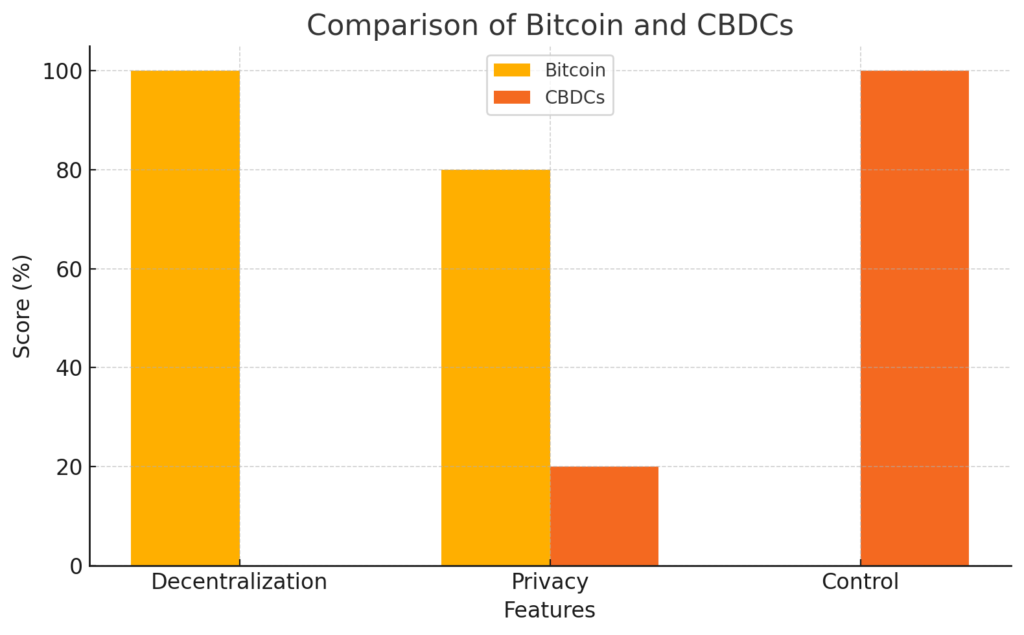The financial landscape is undergoing a significant transformation with the rise of digital currencies. At the forefront of this evolution are Bitcoin and Central Bank Digital Currencies (CBDCs), each representing distinct philosophies and implications for financial freedom.
Understanding Bitcoin and CBDCs
Bitcoin, introduced in 2009, is a decentralized digital currency operating on a peer-to-peer network without central authority. It offers users autonomy over their finances, with transactions recorded on a public ledger known as the blockchain.
In contrast, CBDCs are digital versions of national currencies issued and regulated by central banks. They aim to modernize payment systems and provide a government-backed digital alternative to cash. Unlike Bitcoin, CBDCs are centralized, with the issuing authority controlling supply and transactions.
Comparison of Bitcoin and CBDCs
- Bitcoin:
- Decentralization: 100% (Fully Decentralized)
- Privacy: 80% (Pseudonymous)
- Control: 0% (User-Controlled)
- CBDCs:
- Decentralization: 0% (Fully Centralized)
- Privacy: 20% (Government-Managed)
- Control: 100% (Central Bank-Controlled)
Comparison of Bitcoin and CBDCs

Financial Freedom and Privacy
Bitcoin’s decentralized nature grants users greater control over their assets, promoting financial freedom and privacy. Transactions are pseudonymous, allowing users to manage their funds without intermediaries or oversight.
CBDCs, while offering efficiency, raise concerns about privacy and surveillance. Central banks can monitor transactions, potentially compromising individual financial privacy. Critics argue that this oversight could lead to increased government control over personal finances, challenging the ideals of financial freedom.
Recent Developments and Political Stances
The political landscape significantly influences the adoption and regulation of digital currencies. In the United States, discussions around Bitcoin have reached new heights, with notable political figures proposing bold strategies like creating national Bitcoin reserves to tackle debt. Such initiatives highlight the growing recognition of Bitcoin’s economic potential, though they remain controversial due to its speculative nature.
Meanwhile, the Republican Party’s promise to protect cryptocurrency in its platform signals a significant shift in political attitudes. The party’s opposition to CBDCs and its support for Bitcoin mining and self-custody demonstrate the ideological divide shaping the future of digital currencies.
Global Perspectives and Adoption
Globally, countries are exploring CBDCs to enhance financial inclusion and modernize payment systems. China’s Digital Yuan and Europe’s plans for a Digital Euro exemplify the move toward centralized digital currency. However, concerns about privacy and potential government overreach persist.
Bitcoin, on the other hand, continues to see varied adoption. Countries like El Salvador, which adopted Bitcoin as legal tender, showcase its potential to drive financial inclusion. However, such decisions are met with skepticism by institutions wary of Bitcoin’s volatility and regulatory challenges.
Technological and Economic Implications
Bitcoin’s blockchain technology offers transparency and security but faces challenges like scalability and energy consumption. Its volatility further raises concerns about its suitability as a stable medium of exchange or store of value.
CBDCs promise efficient transactions and reduced costs. However, their implementation demands robust technological infrastructure and carries risks related to centralization and cybersecurity. Striking a balance between innovation and regulation remains critical as these currencies evolve.
The Future of Digital Currencies
The coexistence of Bitcoin and CBDCs presents a complex dynamic in the financial ecosystem. While Bitcoin emphasizes decentralization and financial sovereignty, CBDCs prioritize stability and regulatory control. The future of money hinges on finding a balance between these competing visions.
As digital currencies continue to shape global economies, the conversation around financial freedom and control will remain central. Governments, institutions, and individuals must navigate this rapidly evolving landscape to determine the role of Bitcoin and CBDCs in the next era of finance.
For a more in-depth exploration of this topic, you might find the following video insightful:

